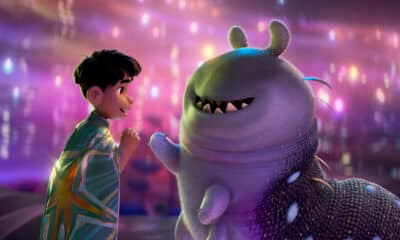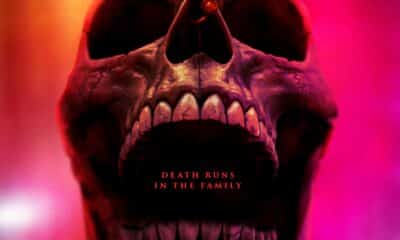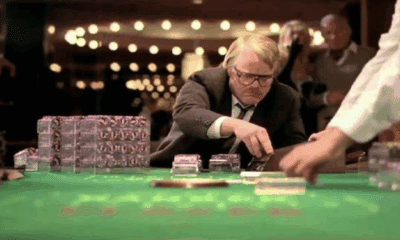Each week, THN looks back at a Walt Disney Animated Classic, from SNOW WHITE to WRECK-IT RALPH, through the obscurity of FUN AND FANCY FREE to the second Golden Age of BEAUTY AND THE BEAST. These are the films the Walt Disney company are most proud of, the ones that hold a special place in our hearts, the ones that still cost a fortune to buy on DVD.
This week, shut off those alarm clocks as we lay in with SLEEPING BEAUTY.
Directed by Clyde Geronimi, Les Clark, Eric Larson and Wolfgang Reitherman
1959/ 76 minutes
Budget: $6 million
Box office: $51.6 million
SLEEPING BEAUTY was a long time coming. Whilst story work began in 1951 and voicework in ’52, the animation process and scoring took over five years to complete. It was the last Disney animated movie to use hand-inked cels, moving onto xerography to transfer the artwork from paper to celluloid (more on that next week).
After SNOW WHITE and CINDERELLA, Disney wanted SLEEPING BEAUTY to stand out from its big sisters by having a radically different style, throwing out the smooth rounded look of earlier works for a much more stylised design, which would correspond to the movie’s time period. Using Super Technirama – which utilised a much larger film area and created a sharper, less grainy picture – the film was intended to break new ground for the Disney studio. Disney appointed artist Eyvind Earle as the film’s production designer, and gave him a significant amount of freedom in designing the settings and selecting colours for the film.
Earle also painted the majority of the backgrounds himself, often taking between seven to ten days to paint one background image; by contrast, a typical animation background took only one workday to complete. Disney’s decision to give Earle so much artistic freedom didn’t go down well amongst his animators, who had until then exercised some influence over the style of their characters and settings.
When it was first released, SLEEPING BEAUTY returned only half its $6 million budget, nearly bankrupting the Disney studio. At the time it was criticised for being too slow paced and having little character development, which isn’t exactly unfair, but later years the film gained a following. Today it’s hailed as one of the best animated features ever made.
SYNOPSIS: The classic fairytale movie opening; a dirty great book is shown on a table and opens of its own accord, as the narrator begins to read the tale; The princess Aurora is born to King Stefan and Queen Leah, named for the sunshine she brings into their lives. As she lies in her crib, Aurora is betrothed to the child Prince Phillip (named after our own Duke of Edinburgh), and three good fairies, pompous Flora, kindly Fauna and feisty Merryweather arrive to bless the child with gifts of great beauty and song. As Merryweather prepares her blessing, Maleficent arrives. Upset for not being invited to the child’s christening, the Dark Sorceress lays a curse upon her; on her sixteenth birthday, she will die after she pricks her finger on the spindle of a spinning wheel. Merryweather is able to soften the curse with her own magic; instead of death, the child will sleep, until awoken by Love’s True Kiss.
To protect the child from Maleficent, the Fairies conspire to care for Aurora themselves, giving up their magic for sixteen years and living as peasant women as they raise the child in seclusion, deep in the forest.
It’s interesting to note that Briar Rose is the first prominent Disney character to be raised by same-sex parents.
Anyway, sixteen years pass and Briar Rose (Aurora) grows into a beautiful young woman. On her sixteenth birthday, her guardians conspire to make her a new dress and birthday cake, before ushering her out of the house, alone, to pick berries. Meanwhile Maleficent, brooding in her castle on the Forbidden Mountain, is unpleasantly surprised to learn her goons have spent the last sixteen years looking for a baby. She then turns to her loyal pet raven Diablo to find the teenager, before time runs out.
While the three old dears make a right mess of the dress and the cake (one wonders how they survived for sixteen years if they can’t even bake a cake between them), Rose ventures into the forest and meets with the Friendly Woodland Creatures. As she sings to herself, she garners the attention of a passing Prince Phillip, who has himself grown into a handsome, headstrong young man. Naturally, they meet and fall instantly in love, not realising each other’s true identity. Rose rushes home, inviting him to find her there later that evening.
Back at the house, things aren’t going well. Frustrated by their failures, Merryweather breaks out the wands, and a charming little sequence ensues. Flora and Merryweather argue about the colour of the dress. Flora, the stubborn matriarch (voiced by Verna Felton, who having voiced the head Elephant in Dumbo is used to this kind of thing) adamantly colours the garment pink, while Merryweather (voiced by Lady, Barbara Luddy) sneakily tries to make it blue (which actually suits the lass better, in my humble opinion). Their magical catfight catches the eye of Diabolo, who quickly cottons on and informs his mistress.
Rose is thrilled by her surprise presents, but heartbroken when the Fairies decide to dump everything on her at once, telling her her true name and identity and that she can never see the young man again. They hurry to bring Aurora home. Phillip, on the other hand, has informed his father, King Hubert, about his plans to meet the peasant girl, and rushes off to see her again, leaving his father behind.
Successfully sneaking Aurora back into the palace, they leave the child alone again to give her a moment to regain her composure. As soon as the door is closed, Maleficent makes her move, and draws Aurora higher into the palace towards an enchanted spinning wheel. The Fairies rush to save her, but arrive too late. Maleficent stands triumphant over the fallen princess, just as the sun sets on the kingdom. Unable to bring themselves to tell Aurora’s parents of their failure, the Fairies instead put the entire kingdom under the same curse as Aurora. As the entire kingdom slips into slumber, Flora overhears King Hubert trying to tell King Stefan about the “peasant girl”. Putting two and two together, the Fairies rush to find Phillip.
Alas, Phillip has fallen into the clutches of Maleficent, who has him locked in the dungeons of her castle. Finding his hunting cap in the deserted house, the Fairies journey to the Forbidden Mountain to rescue the Prince, who, by this point, has done more than both his dramatic forebears combined.
Bored of her minions’ revelry, Maleficent taunts Phillip with a vision of the peasant girl, revealing to him that she is the very Princess to whom he is betrothed, and who now sleeps peacefully in wait for Love’s True Kiss. Maleficent teases Phillip with the knowledge she will keep him under lock and key for the rest of his life, only to release him as an old and frail man, to finally meet his sleeping love, who will not have aged a day. She departs, delighted with his righteous fury. However, the Fairies sneak in and bust Phillip out, arming him with the Sword of Truth and the Shield of Virtue. They then provide cover fire for his escape from his prison cell and Maleficent’s assorted minions, including Diablo, who is turned to stone by Merryweather.
Seeing her beloved lieutenant’s fate, Maleficent conjures a forest of thorns around Stefan’s palace, which Phillip valiantly battles through. As a final resort, Maleficent transforms herself into a colossal dragon to battle the Prince herself. Phillip is quickly overpowered and all seems lost, until Phillip throws the enchanted blade into Maleficent’s heart. She falls to her death and fades to ash.
With Maleficent and her magic destroyed, Phillip awakens Aurora, breaking the spell on her and her kingdom. The royal couple descend to the ballroom to be reunited with their parents… And they live happily ever after, though Flora and Merryweather still bicker about the colour of the dress.
Lessons Learned:
1. Hell hath no fury like a woman scorned.
2. Never send goons to do a henchman’s job.
3. Though they mean well, Fairies can be a bit thick. I mean, honestly, none of them really thinks anything through; why not keep the child safely away from Maleficent and the castle for, I dunno, seventeen years? Sixteen-and-a-week, maybe, just to be sure?
Anyway…
THE HEROINE
![]()
![]()
![]()
Princess Aurora/ Briar Rose, voiced by Mary Costa. The first Disney Princess to actually start out as one, for the most part, Aurora is a naive but well-rounded character. Raised in seclusion, she has little knowledge of the outside world. The thing with Aurora is, she’s not actually in the movie that much. She seems to have less screen time than anyone; she has only one song, and only a handful of scenes. She’s completely silent for the second half of the movie; even after she’s woken, she doesn’t say a word.
It could be argued the three Fairies are the real heroines, as much of the running time revolves around them. In which case, they get one star each; each has their moments, but each has their failings. Out of the three, Merryweather is by far the best character. The others just come across as a bit one-dimensional.
THE HERO
![]()
![]()
![]()
![]()
Prince Phillip, on the other hand, is the first Disney Prince to do, well, anything. Much like the Prince from SNOW WHITE, he’s a bit of a sneak, but he more than makes up for it by actually having a personality and setting out to do something about his true love’s plight, setting the template for the likes of Hunchback’s Phoebus and Tangled’s Flynn Rider, amongst countless others.
THE VILLAIN
![]()
![]()
![]()
![]()
![]()
Eleanor Audley returns. After voicing CINDERELLA’s Lady Tremaine, who else could have brought Maleficent to life, and give her such depth. Where she could have been so much less with another actress providing her voice, Maleficent shines on celluloid. It’s easy to see why she’s become such a treasured character. Powerful and merciless, with one hell of a mean streak, Maleficent stands tall (literally and figuratively) over Disney Villains before or since. Let’s hope Angelina is up to the job.
SIDEKICKS/HENCHMEN
![]()
![]()
![]()
![]()
Like I said, it can be argued Aurora isn’t quite the heroine here. I’ve said pretty much all I need to on the Fairies, but Diablo deserves a mention. Despite being mute (well, no spoken dialogue anyway), he stands at his Mistress’ side and comes to her aid at the eleventh hour.
PLOT
![]()
![]()
![]()
There are tonnes of loopholes in the plot. How did the three of them raise a child on their own for 16 years without any real knowledge or experience. How come Maleficent didn’t check on her goons’ progress, and realise their blunder earlier? What’s she been doing for all that time? How does burning every spinning wheel help? Nothing’s going to happen for 16 years, just burn them all the day before Aurora is due to return. Why didn’t Aurora’s guardians explain this all to her in the first place and swear her to secrecy?
But, considering it’s a cartoon film based on a seventeenth-century fairy tale, and it’s balanced out by a good deal of action, I’m inclined to let it slide.
LAUGHS
![]()
![]()
![]()
SLEEPING BEAUTY is played straight for the most part, with the main bulk of comedy coming from the two Kings; in the one scene they have together, as they drink and sing to their children’s impending marriage, most of the laughs lie. It serves to lighten the tone before it gets progressively dark in the final reel, but does little to progress the story.
SCARES
![]()
![]()
![]()
![]()
![]()
In either form, Maleficent is just damn scary. The fact her motive is so human only helps to raise the bar. She’s holding a grudge for not being invited to a royal occasion. Hell hath no fury like a woman scorned, but when the woman has the powers of Hell itself at her command, it’s a whole new world. Ahem.
The sequence where Maleficent draws Aurora through the darkened palace to her fate is haunting, as is her taunting of the Prince, but in the final act it kicks up a gear, as Maleficent literally becomes a creature of nightmare which lingers long after her (surprisingly swift) demise.
MORAL/ EDUCATIONAL VALUE
![]()
![]()
![]()
The Fairies make lousy guardians; they fear for her life at the hands of Maleficent, then shoo her off into the forest. They do at least warn her not to speak to strangers, and in fact she does at least attempt to flee when Phillip comes prowling. Phillip is a half-decent role model; he follows his heart, challenges the established status quo, and almost literally fights through Hell to save Aurora from her slumber.
MUSIC/SONGS
![]()
![]()
![]()
![]()
![]()
Based upon the 1890 ballet of the same name by Pyotr Tchaikovsky (who also gave us the Nutcracker Suite segment of FANTASIA), the score is beautiful. The songs bolted to them aren’t always great, but a few stand out. The main song, Once Upon a Dream, based upon the Sleeping Beauty Waltz, is the kind of song that stays with you and stands well as a romantic ballad. It’s also very atmospheric, especially in this sequence.
I’m afraid my knowledge of classical music isn’t good enough to tell you which Tchaikovsky arrangement this is based on, if any, but it’s certainly one of my favourite pieces from the whole film.
LEGACY
![]()
![]()
![]()
![]()
Much like its well-known siblings, SLEEPING BEAUTY has been the basis for theme park rides, games and other films for over half a century, as well as becoming one of the jewels in the Disney crown. Aurora became one of the founding members of the Disney Princess franchise, as well as featuring as a Princess of Heart in the Kingdom Hearts series, which also boasts Maleficent as one of the main antagonists. It was nominated for Academy and Grammy Awards for its score and soundtrack, losing both to PORGY AND BESS. (Never heard of it).
About the time SLEEPING BEAUTY was in production, Disney were busy with the construction of the first Disneyland. To help promote the film, the park’s iconic castle was named “Sleeping Beauty Castle” (it was originally meant to be Snow White’s). Several other Disney parks around the world have one much like it; the one at Disneyland Paris even has a dragon!
And, lest we forget, a live action “version” of the tale is inbound. Scheduled for release July 2014, MALEFICENT will see the story told from her own point of view, with Angelina Jolie taking the title role, and Elle Fanning as Aurora. Will it match up to the original? We’ll let you know we think in due course.
FINAL SCORE: 40/53
Sources: Wikipedia, Disney Wiki, IMDb, youtube, disneyclips.com

Latest Posts
-


Television
/ 24 hours agoHarry Potter, Hermione Granger and Ron Weasley cast in new HBO Max series
The three main child roles in the planned Harry Potter TV series have been...
By Paul Heath -


Netflix
/ 24 hours agoNetflix unveils a ‘One Piece’ announcement video
One Piece season two is officially a go and here’s a two-minute teaser for...
By Paul Heath -


Film News
/ 1 day ago‘Sinners’ will come to premium digital in one week
One of the best-reviewed studio films of the year, and indeed one of the...
By Paul Heath -


Film News
/ 1 day agoDisney and Pixar’s new film ‘Elio’ has a new trailer
Check out this brand new trailer for Disney and Pixar’s new film Elio. The...
By Paul Heath






